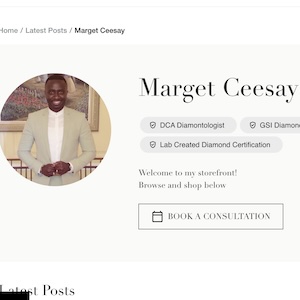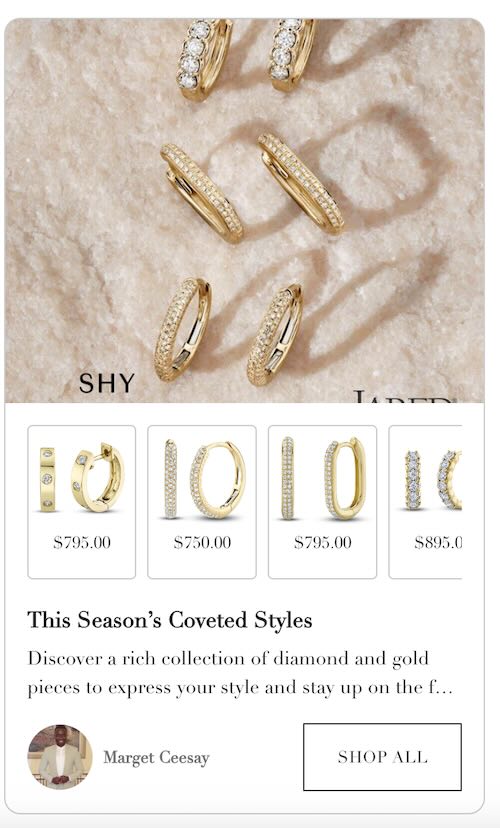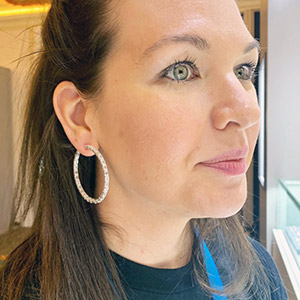
Let’s say you’re an engagement ring customer. You go to your local jewelry store and see a few items you like, but you’re not ready to pull the trigger just yet.
The next day you have only a vague memory of what you saw. That is, until the salesperson sends you a text, leading you to a link that lays out all your choices and options—along with a button enabling you to buy now. Your salesperson’s face is on top of the page.
When it’s time to purchase your wedding ring, you receive another text, with another page of curated choices and recommendations, as well as more buy buttons.
What you’ve encountered is a “digital storefront,” which Signet introduced last year as a way to fuse the personal touch desired by most jewelry shoppers with online convenience. And these digital storefronts are going “gangbusters,” Signet’s chief digital officer Rebecca Wooters tells JCK.
“Sales have been nearly three times what we anticipated,” she says. “People like the convenience of having personalized recommendations at their fingertips.”
The idea was born when Signet noticed that its jewelry consultants, both online and in-store, were forging relationships with consumers. The company arranged to have salespeople send shoppers curated style boards—which were later rechristened “digital storefronts.” Signet expanded the service to 10,000 jewelry consultants this year.
Signet sees them as a way to extend the retailer’s relationship with both bridal and fashion customers beyond their initial visit.
For example, Wooters says, “we had a customer who wasn’t anywhere near a store and he had to drive an hour to get to one, and he wanted his daughter to go with him, because he was looking for something for his wife. A consultant showed them three or four things in the store that he leaned toward. The consultant then put the style board together of those items so the customer could share it with his daughter and get her opinion. He ended up purchasing a tennis bracelet through the style board.”
In another case, a soldier who was being deployed overseas purchased a piece from Signet’s bridal collection through a storefront.
“He had a couple of options he was considering that the consultant was able to configure for him through a style board,” Wooters explains. “She sent it to him, and he ended up purchasing a ring. They messaged back and forth, and he asked for help on the actual proposal.”
Sometimes, salespeople will send the storefronts to customers before life milestones or—if they’re habitual jewelry shoppers—just to keep in touch.
“If a consumer came and purchased before Christmas, they’ll get something before Valentine’s Day,” says Wooters. “[The communications will] say, ‘Hey, these five new products came in’ or ‘It’s coming up on a holiday’ or ‘Here are five things that are trending right now.’”
So far, 3 million people have chosen to receive a digital storefront, Wooters says.
“What’s nice is customers are a lot more likely to opt in to this experience, because it’s like having your personal stylist,” she says. “You hear people talk about having ‘a guy who can help me.’ That’s what happens here.”

The style boards are sent out via email, text, and social media—but texts are far and away the most popular option, according to Wooters. And because the messages are personalized, they have far better open rates than standard mass promotions.
While the boards are generally compiled by consultants, Signet is experimenting with using artificial intelligence to help choose the items.
“We have created style boards from data, based on what we know about the customer journey,” Wooters says. “We want to make sure that when we send out products to certain consumers based on their interests, we’re sending the products that most make sense for them.”
She was originally surprised that the boards proved popular with customers for all Signet banners, not just the more fashion-oriented mall stores.
“If you had asked me ahead of time, I’d have said that Kay or Zales or Banter [the former Piercing Pagoda] would be a better candidate,” she says. “But they’re working across all of our banners, and the reason they’re working is because they’re personalized.”

As part of this program, Signet has trained senior management—including CEO Gina Drosos (who is retiring in November)—on how to put together digital storefronts.
“Gina has put style boards together and has actually sold several thousand dollars worth of jewelry on her own to friends and family,” Wooters says. “She was very proud of that.”
(Photos courtesy of Signet)
- Subscribe to the JCK News Daily
- Subscribe to the JCK Special Report
- Follow JCK on Instagram: @jckmagazine
- Follow JCK on X: @jckmagazine
- Follow JCK on Facebook: @jckmagazine







